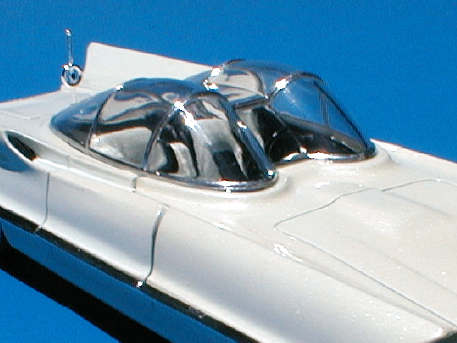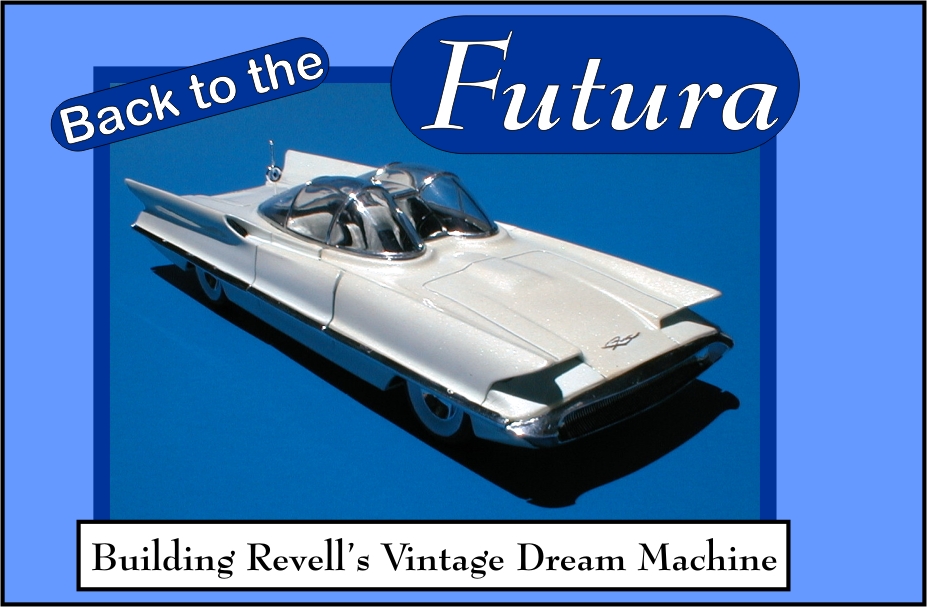
The fifties were the golden age of Detroit’s “dream cars” and at the top of the list was Ford Motor Company’s Lincoln Futura. Billed as a $250,000 rolling laboratory, the Futura not only looked like the fifties version of the future, but also was a fully functioning engineering marvel that foreshadowed a number of features that would later find their way into production.
This is particularly true of design elements like the fins and deeply hooded headlights, which made their way (in a somewhat modified design) to the 1957 Lincoln. The Futura was a major star on the show circuit from its unveiling in 1955 until its retirement in 1959.
After it was withdrawn from public life, the Futura languished for a few years, but was finally resurrected by famed customizer George Barris as the original Batmobile for the mid-sixties television series. It still exists in that form today, and although it still has a huge following of devotees, I am one of the minority opposition who deeply regrets the fact that the Future wasn’t preserved in its original form.
Fortunately Revell chose to model the Futura as one of its first 1/25th scale kits in 1956, along with the Pontiac Club de Mer. Even better was the reissue of the original Futura kit back in the 90s.
I became a model car addict very early, around age 5, thanks to an uncle who was a Ford salesman. Every year he would present me with a promotional model of that year’s new Ford, beginning in 1950. I also remember various Christmas and birthday gifts, like a fully chrome plated ’53 Pontiac with operating headlights, a ’54 or ’55 Cadillac Coupe de Ville friction, and one of AMT’s remote controlled ’56 Fords.
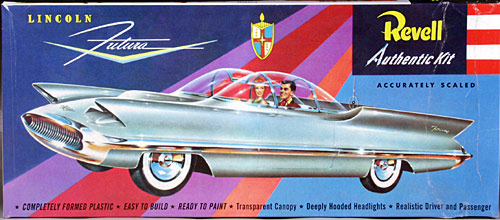
I had also watched in fascination as my older brother spent hours building various models from Revell’s Highway Pioneer series, but even then I had developed a bit of a prejudice against models that weren’t 1/25th scale. But then came the Futura kit and it was my turn. The Revell Futura was the first model car kit I ever built…the original issue, probably some time in 1957.
Of course, after it was assembled…no easy task for an eleven-year-old…it became just another toy in my stable of model cars. Consequently, it didn’t last very long. I gradually matured into a fledgling collector around 1960, but by then my original Futura was long gone. Some time in the mid-sixties I came across an out-of-the way hobby shop that had a large stock of older model kits, including several Futuras. I managed to score several for a buck apiece! I sold the excess to other collectors, probably for a (at that time) nice profit, but nothing to compare with what they would have brought in succeeding years. Prior to the re-release, a mint Futura kit would bring several hundred dollars, on those rare occasions when one would be uncovered.
My return to the model car hobby after an absence of about fifteen years coincided nicely with the re-release of the Futura, and I snapped up the first one I could find. By then my building techniques had improved significantly, so then began one of the longest "kit grokking" periods I’ve ever experienced. I had the kit for about four years before I finally got around to building it.
Part of this was because I couldn’t quite decide what I wanted to do with it. I initially considered using it as a basis for a full-detail replica, but after a fair amount of research, I decided that this wouldn’t be a very practical approach. There isn’t a lot of information available about the Futura, because most of the records were destroyed in a fire at Ford Motor Co. in 1962. A lot of conjectures have been made about the car, but many are just that…conjectures. So, lacking what I considered sufficient information, I finally decided to build it box stock. Even so, this still required a fair amount of research, and my primary source became the December 1996 issue of Collectible Automobile magazine, which contains a large feature story on the Futura. A secondary research source was the Internet, and I found a lot of additional photos and information through a number of Web searches. Finally I was ready to begin.
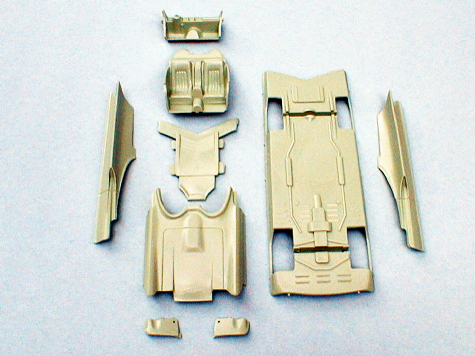
The first step was to prepare all the parts, remove flash and take care of any minor imperfections. This was surprisingly easy, especially in view of the age of the original tooling. For the most part the reissued kit was very clean, with very little flash to contend with…not bad for a 40+ year old tool!
Next came the painting. This was no simple feat for a number of reasons. Very few color photos of the Futura exist, and most of those are quite old and the colors have faded and/or shifted. But using those as a basis, along with the Collectable Automobile article, which described the color as a “pearlescent, frost-blue white” I had an idea of what I wanted to do.
Because of the way the kit was engineered and the way it builds up, it wasn’t possible to pre-assemble the multi-piece body prior to painting. I was concerned about possible minor color differences between the individual body panels, so I decided to mount them all on a large sheet of cardboard so they could be painted simultaneously.
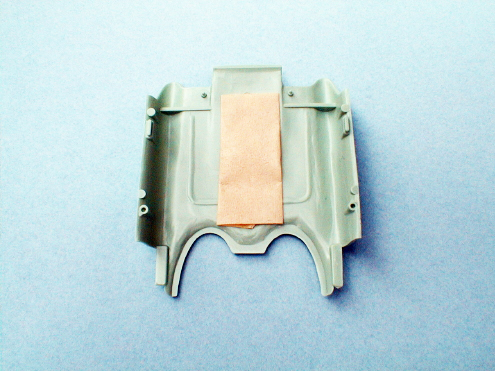
To make sure I could easily get to all the surface areas of each part, I cut pieces of Styrofoam, thick enough to make sure the parts would be well above the cardboard surface,
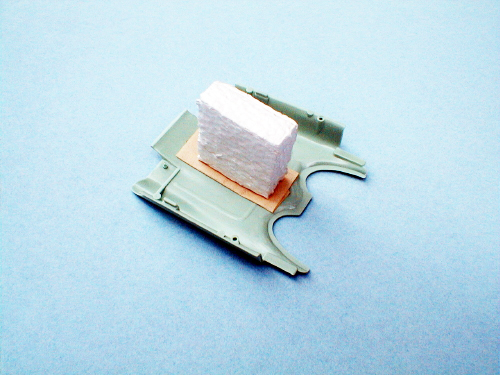
and used double-sided pieces of masking tape to mount them.
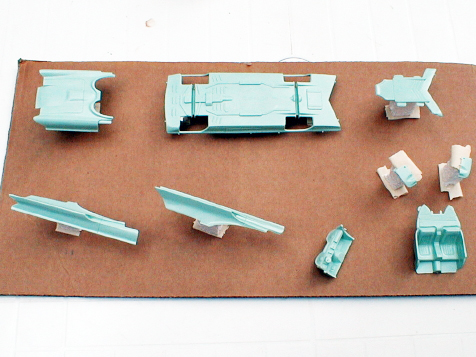
This technique came in handy because the cardboard acted like an artist’s palette throughout the painting process. I was able to hold it and turn it to various angles to make sure I had uniform coverage on all the parts. The only precaution I took was to make sure the parts were securely fastened down so they wouldn’t fall off. The two main interior parts were also included, because according to my research, part of the Futura’s upholstery was color-keyed to the exterior paint.
Since I couldn’t find any paint available commercially that would come close to my vision of the blue-white I needed for the color coat, I decided to mix my own, using the familiar small bottles of Testors enamel, mostly gloss white, with just a touch of dark blue. Once I had the color I wanted I thinned it down to a milky consistency for use in my airbrush.
I also wanted to make sure I’d have enough for the multiple coats I anticipated applying, so I wound up using four small bottles of white, thinned with three small bottles of thinner. I added the blue by dipping just the tip of an old paint brush handle in the blue and stirring it in until I got the shade I wanted. Because this was the first time I had used thinned enamel like this in my airbrush, it took a bit of experimentation to get it right.
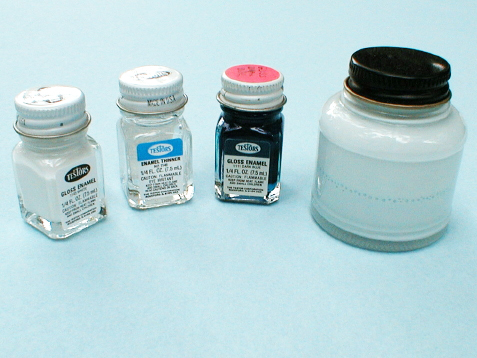
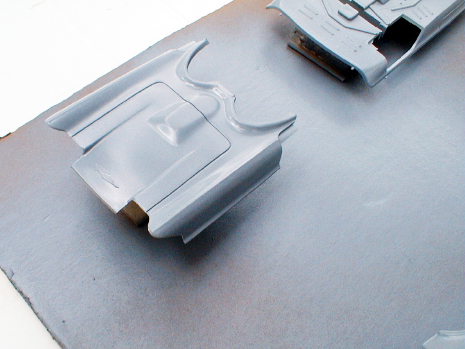
The first decision I made was to use a primer coat, because I wasn’t sure how well the thinned enamel would adhere to the plastic. This was one of those “between a rock and a hard place” kind of decisions. Although I needed to be sure the paint would adhere properly and evenly, I also knew that I would eventually be building up quite a few layers of paint and was apprehensive about covering up details.
I had only been using an airbrush for a couple of years, so I was still a bit of a novice when it came to painting with it. I had a few rattle cans of primer in stock, and since I wanted to use them up, I used them for the primer coat. This was probably a bit of a mistake, because even though I did my best to make it a light coat, it still went on thicker than it would have with the airbrush. I could have stripped the primer off and started over, but decided I’d take a chance and see how it went.
After the primer was dry, I started lightly laying on the color coats. The first three went on nicely, although they weren’t covering the primer all that well because I had thinned the paint fairly well. But after three more slightly heavier coats, I was beginning to get the coverage I was looking for.
I originally figured that it would take a fair amount of drying time between coats, because enamel dries much more slowly than lacquer. However, that didn’t seem to be the case, probably because the paint was so thin. I waited until it felt “tacky-dry,” about thirty minutes, between coats.
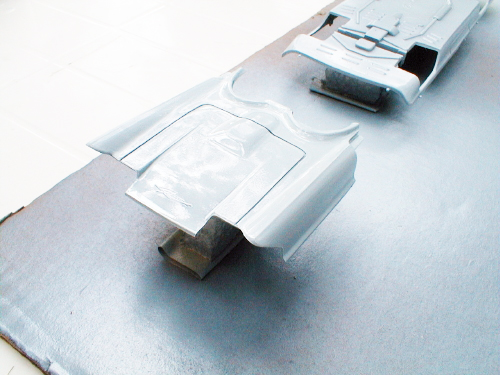
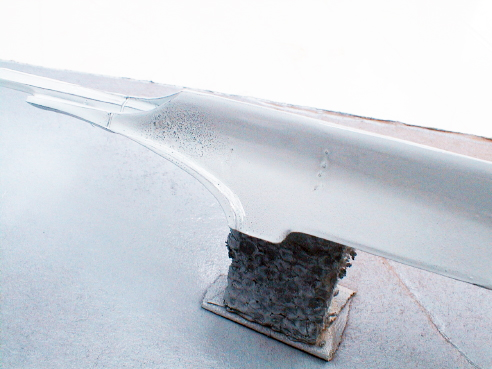
Then disaster struck! I put down a couple more coats, this time a little wetter than the previous ones. Either the paint was too thin, or more likely, I hadn’t waited long enough between coats, because all of a sudden, the enamel coats began to separate a bit and spots of primer began to show through on a couple of the panels.
One thing I’ve tried to learn over the years is to quit at the right time. So I did just that. Rather than try to fix the problem right then, I set the whole project aside for several weeks. That would give the paint I had applied so far sufficient time to dry and gas out enough for me to tackle making the necessary corrections. In the meantime, I finished up a couple of other projects, which is one good reason for having several going on simultaneously. If you run into a problem with one, setting it aside and moving on to another usually helps reduce the frustration factor significantly and improves your chances of successfully dealing with the problem project at a later time.
Actually, a little more than a month went by before I went back to the Futura. By that time the initial paint had pretty well-cured and I was ready to tackle the problem. I still strongly resisted stripping the paint and starting from scratch; although this was a definite possibility, I was saving that as a last resort. I got out the old fine grit sandpaper and went to work, carefully feathering the edges of the problem areas as I sanded them down. In some cases I only had to go down to the primer layer, but in others, by the time everything was smooth, I was back down to the bare plastic. I really didn’t want to go through the whole primer trip again, so I decided I’d attempt doing a repaint, skipping that step.
By this time I was running low on the original paint mixture so I mixed
up another batch, this time not quite as thin as the first batch. Three
additional coats of the new mix did the trick. It went on smoothly and
covered everything completely. I was pleased with the detail that
was still visible through the paint, especially the Futura emblem on the
hood.
The final step in the painting process was to apply a pearl top coat. Initially I thought I’d have to use a pearl overcoat and then clear gloss over that, because I've found that most pearl finishes don’t have much of a gloss to them. But I used a rattle can of Testors Gloss Pearl Clearcoat to lay on two coats and it dried with all the gloss you could ask for.
The only downside was it went on a bit thick, and I wound up with some of the detail of the hood emblem somewhat obscured. This could have probably been avoided several ways, including airbrushing the initial primer coat or the pearl gloss coats, but overall, I was pretty well pleased with the results.
I decided to go ahead and take a chance that I’d be able to polish through the paint sufficiently to uncover the emblem. If worse came to worse, I could always strip the paint and start over. After all, a lot of this had been intended a learning process, and I had already learned quite a bit!
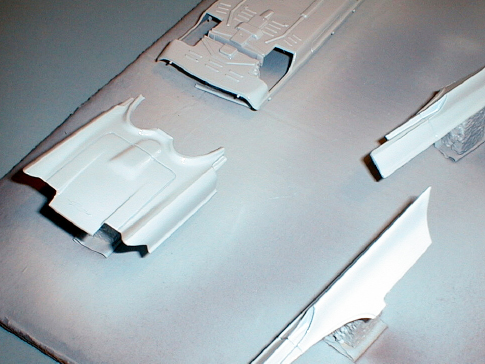
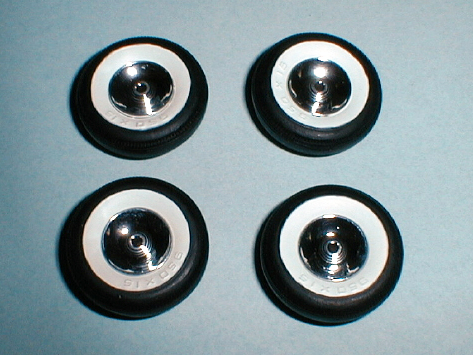
While I was waiting for the paint to gas out and cure enough so it could be polished, I went back to a couple of other projects, but also started doing some work on the Futura’s sub-assemplies.The first thing I tackled were the tires, which were two-piece plastic as was often the case with early kits. I considered replacing these with more modern tires, but finally decided to stick with the originals, mostly to maintain the “box-stock” nature of the finished model.
Although prior to assembly and painting they looked a little funky, once they were finished, the overall appearance wasn’t too bad after all. The Futura’s wheel openings are fairly small, so less than half of the tires show. The main objection I had to the way they looked was the huge lettering on the sidewalls, but again, to stay true to the original kit, I left that in place.
Painting the interior was fairly easy, in spite of the fact that it was made up of only two major components. Some detail in the original tooling was lacking when compared to photos of the 1:1 vehicle, but considering the age of the tooling, once painted it looked pretty good.
Here’s where I depended heavily on the Collectible Automobile article as well as my Internet research. In addition to the photos, the magazine article gave quite a detailed text description of the interior color scheme and layout. The outer areas of the seats and sections of the door panels were the same color as the exterior. The rest was done in a combination of satin black and brushed aluminum.
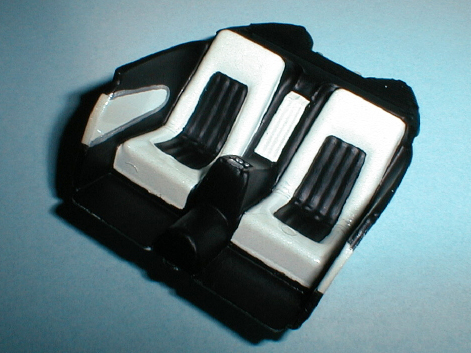
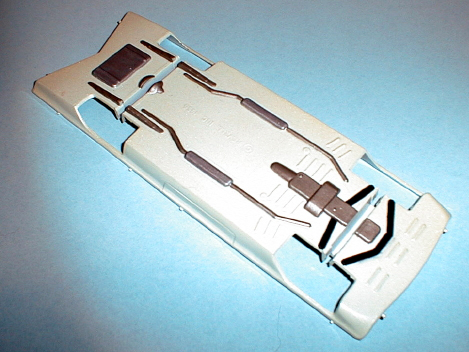
One unresolved mystery is the Futura’s rumored bellypan. Although Revell engineered the model depicting a bellypan, the research I uncovered gave no indication that one was ever used on the original vehicle. The chassis and running gear were modified from stock ’53 Lincoln components and nowhere does anything indicate a bellypan was ever made for it.
It’s possible that some of the original engineering plans called for a bellypan, and that may be what Revell worked from in designing the kit. That’s just a guess, and we’ll probably never know for sure. However, I stayed with the bellypan concept when it came to painting and minor detailing of the underside.
Before I started the actual assembly, I did a preliminary polishing of the various body components using Novus No. 2 fine scratch remover. I also followed the kit’s instruction sequence. Assembly was fairly easy because the Futura is essentially a very simple kit.
The wheels and tires are positioned onto heavy metal axles, which are then snapped into place in slots on the chassis/bellypan component. Then the rear interior section is attached to locating pins on the same assembly. Next comes the dashboard and steering wheel.
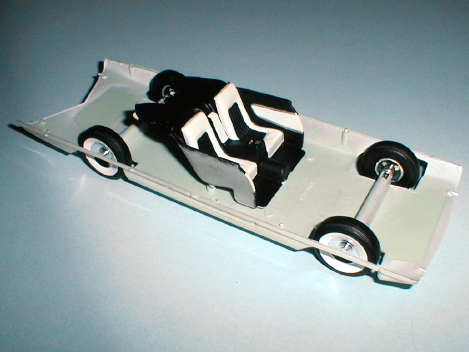
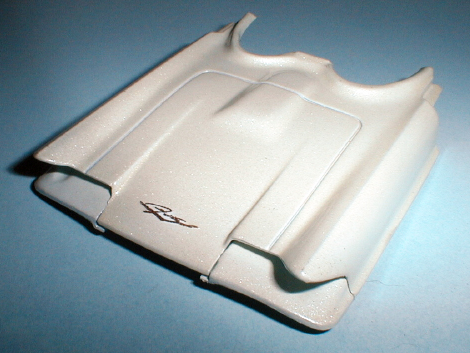
Then I had to tackle the hood assembly. In spite of my best efforts, the Futura emblem was somewhat obscured by the number of coats of paint. I approached the problem with the Novus polish and some cotton swabs. Using the swabs, I was able to focus my polishing efforts more or less to just the paint-covered emblem. It took a bit of work, but the final results weren’t too bad. I used gold paint and a very small brush on the hood emblem.
The headlights and headlight pans were attached to the hood sub-assembly, then it was mounted on the chassis assembly.
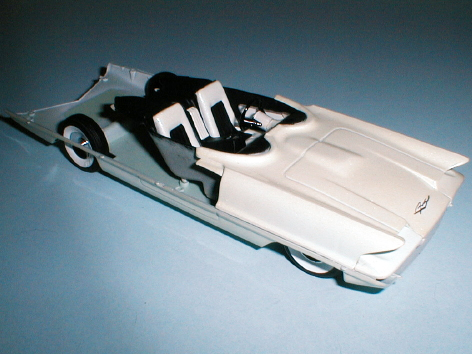
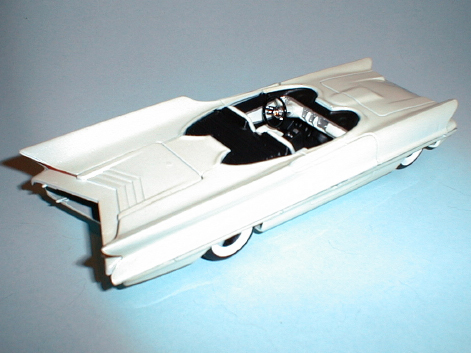
The taillights were painted and installed in the fenders, the rear fender scoops were detailed with flat black, and the rear fender assemblies were mounted to the trunk panel.
This got a little tricky--one of the more difficult aspects of these older kits were the multi-piece bodies, so I used transparent tape on the underside to hold the sub-assembly together while I attached it to the chassis. This made it a lot easier to keep things in alignment.
I applied Bare Metal foil to the canopy and detailed the grille, rear bumper, and center-mounted trunk antenna with thinned flat black acrylic paint.
Finally, those pieces, along with the side trim were attached to complete the basic assembly. I had a little trouble aligning the side trim because the locator pins seemed to be a bit “off” so I trimming them off.
The final steps dealt with applying very small pieces of chrome foil to the points where the chrome side trim had been attached to the sprue.Then a final once-over with the polishing kit and the project was complete.
This was my first experience with the Novus polishing system and I was very impressed. The No. 2 Fine Scratch Remover gave a beautiful smooth gloss, and then an application of the No. 1 Plastic Clean & Shine brought everything to a higher shine than I realized was possible on a plastic model. I’ve now joined the crowd of Novus converts!
